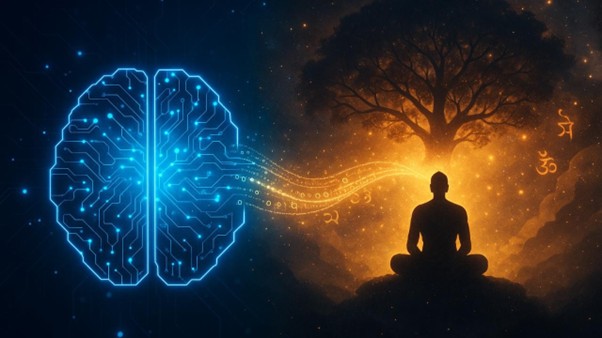Introduction
Imagine a world where the profound healing insights of our ancestors, preserved in ancient texts, are seamlessly integrated with the cutting-edge advancements of modern science. For centuries, humanity has admired ancient civilisations not merely for their awe-inspiring structures, such as the pyramids, but also for their pioneering achievements in astronomy, engineering, and medicine. These innovations laid the foundations of modern scientific thought.
The convergence of ancient wisdom and advanced artificial intelligence offers an unprecedented opportunity to transform our approach to health and well-being. Traditional healing systems, rooted in observation, intuition, and harmony with nature, have long emphasised the interconnectedness of mind, body, and environment. Today, AI opens new possibilities for understanding these insights on a scale never before possible. By analysing vast troves of medical texts, patient histories, and genomic data, AI can decode patterns that resonate with Ayurveda, Traditional Chinese Medicine (TCM), and other ancestral practices. Imagine algorithms that not only track symptoms, but also integrate environmental, emotional, and genetic factors.
The Amazing Brilliance of Our Ancestors (samples)
- Pyramids of Giza: 2.3 million stone blocks aligned to true north within three minutes of accuracy.
- Babylonian Stargazers: Charted planetary cycles and predicted eclipses by 750 BCE.
- Antikythera Mechanism: A 2,100-year-old geared “computer” tracking sun, moon and eclipse motions.
- Iron Pillar of Delhi: Over 1,600 years old and still rust-free without modern coatings.
- Invention of Zero: India’s invention of zero and the place-value system enabled advanced calculations long before Europe adopted them.
- Aryabhata (476–550 CE): Described a spherical, rotating Earth and estimated its circumference at 24,835 miles—almost identical to modern measurements.
The Limits of Modern Medicine (we are grateful but….)
- Lifelong reliance on medications for conditions like diabetes, hypertension, autoimmune disorders, and heart diseaseis common.
- Specialisation excels at managing symptoms but can overlook the underlying root causes.
- Many seek functional and holistic approaches that address genetics, lifestyle, and environment.
- Quality of life is considered more important than longevity alone.
- Across the animal kingdom, creatures instinctively use plants to heal—a testament to nature’s inherent pharmacy. Many modern drugs trace their origins to botanical discoveries in traditional systems.
- Traditional healing systems integrate spiritual, psychological, and social dimensions often not addressed in reductionist models.
The Revival of Ancient Medical Wisdom Through AI
Roots of Modern Medicine
Many contemporary drugs and therapies can trace their origins back to botanical discoveries within traditional healing systems. Unlike generic symptoms suppressing approaches, traditional healing integrates spiritual, psychological, and social dimensions, offering a holistic perspective on health.
The Role of Artificial Intelligence
Artificial intelligence (AI) now acts as a bridge, reviving lost wisdom by unlocking ancient medical texts that were once inaccessible due to language barriers and the passage of time. With large language models, GPU speed and advanced translation capabilities, AI enables the digitisation and study of age-old manuscripts.
Digitisation of Traditional Medical Knowledge
Portals such as India's SAHI, NAMASTE, and the TKDL have played a crucial role in digitising the vast knowledge from Ayurveda, Siddha, Unani, Sowa Rigpa, and Homoeopathy. Across continents and centuries, brilliant minds documented their healing practices—recordsthat are now being made accessible and analysable through AI.
Classical Medical Texts
- Charaka Samhita (~1000 BCE): A foundational Ayurvedic text focused on internal medicine, diagnostics, and preventive care.
- Sushruta Samhita (~600 BCE): The world’s earliest surgical manual, detailing over 300 procedures including plastic surgery and cataract removal.
- Ashtanga Hridaya (~600 CE): A synthesis of earlier Ayurvedic knowledge by Vagbhata, covering medicine, surgery, and lifestyle guidance.
- Agathiyar Vaithiyam: Attributed to sage Agathiyar, this Siddha text covers herbal formulations, pulsediagnosis, and spiritual healing.
- Theraiyar Yamakam: A poetic medical treatise by Theraiyar, detailing disease classification and treatment protocols.
- Nayanaviti-500: A classic ophthalmology text attributed to Akattiyar, describing 500verses on eye diseases and remedies.
- Huangdi Neijing (Yellow Emperor’s Inner Canon) (~300 BCE): The oldest text in Traditional Chinese Medicine, covering acupuncture, herbal medicine, and the foundational yin-yang theory.
- Shennong Bencao Jing (Divine Farmer’s Materia Medica) (~1st century CE): A catalogue listing hundreds of herbs and their medicinal properties.
- Shanghan Lun (Treatise on Cold Damage) (~200 CE): A clinical guide for infectious diseases, still referenced in herbal therapy today.
Reimagining Health: A Future Rootedin Wisdom and Powered by Technology
The convergence of ancient healing philosophies and modern AI is more than a scientific revolution—it represents a transformational shift in how we view and care for the body, mind, and spirit. By harnessing ancestral insights alongside technological precision, we are not reinventing wellness, but rediscovering it.
The Rise of Integrative Healthcare
- Personalised, preventive, and holistic healthcare.
- Empowered by AI, guided by timeless knowledge.
- Built on scientific evidence, yet rooted in human experience.
It is not “East vs. West” or “tradition vs. science”—but rather the power of “and”.
East and West Tradition and Science
Let us build a healthier world by bridging millennia.
Enjoyed the read? Let’s take it further.
Connect to unlock exclusive insights, smart AI tools, and real connections that spark action.
Schedule a chat to unlock the full experience
